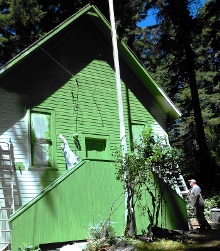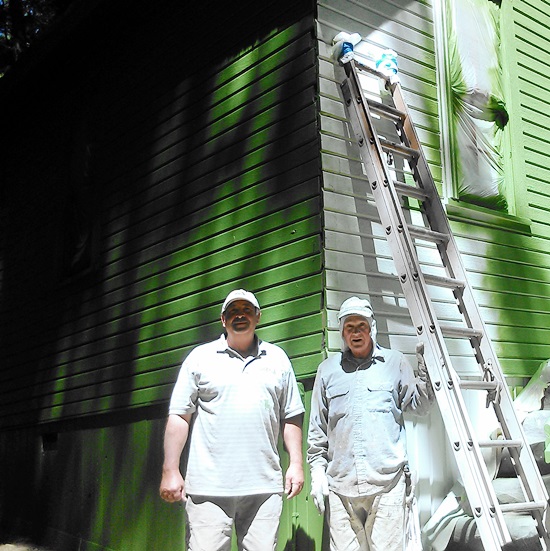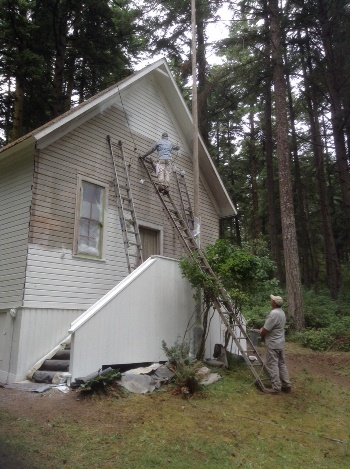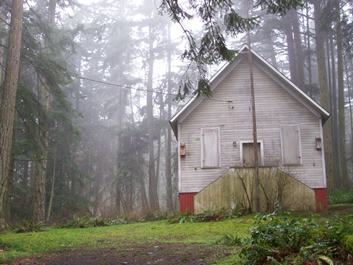— by Margie Doyle —
Mike Wiley has one last job before he retires on July 1. Drive down Crow Valley road to the historic school, now part of the Orcas Island Historical Museums. Mike has been there with Phil Schultz painting the building — its first paint job since it was first built in 1888.
When it’s finished, so is Mike Wiley, island painting contractor. When he retires it will be the end of an era among island contractors who sought Mike out for his expert painting craft.
Mike’s daughter Michele “volunteered” him to paint the Crow Valley School last year. Rodda Paint and Island Hardware chipped in with the paint and materials. The final color may surprise some, but it was documented and selected by Richard Schneider who previously owned and restored the school with Bud McBride.
The school won a Governor’s Award for Historic Preservation during Washington State’s Centennial in 1989. Schneider and McBride deeded it over to the Orcas Island Historical Museum in 2013.
At that time, Historical Society volunteer Margot Shaw wrote: “In 1888,when Washington was still a territory, the Pleasant Valley School (later called Crow Valley School) was built on one acre of land, donated by settler Peter Frechette. In the heyday of Orcas’ fruit orchard industry, the one-room school had as many as 47 students enrolled, 27 average in attendance.
“The school closed in 1918, after which the consolidated Eastsound school served the whole island. The building continued to be used for community events, housing a women’s club, the “Willing Workers” (later called the Crow Valley Club). ”
The Museum keeps the Crow Valley School open during the summer, with docents on hand to describe what school was like in the days before automobiles or the internet. As Mike Wiley and Phil Schultz worked, they would look up at the trees and hear a school bell from the old days, and laughter in the school yard, when kids came to school on horseback.
They pressure-washed and prepped the school — “the hard part of the job ” according to Wiley: squaring up the shutters; removing the corner boards; and back-brushing “every nooks, hole and cranny. “I couldn’t have done this without Phil,” Mike says.
Mike Wiley is one of us who came to the island as a tourist to visit his cousins Larry and Sue Croft, in 1980, and decided to stay. He was en route on his Gold Wing motorcycle to make a trans-Canada trip. But instead, he extended his stay on island and canceled the rest of his trip. “The Orcas bug bit me,” he says, and he returned to central California with plans to move here.
Within a year, he had closed his business as a manufacturing representative, sold his farm, and moved to Orcas Island.
He apprenticed as a painter to “two old Swedes,” who, he says philosophically, were probably younger than he was when he trained many young college students and summer workers.
While Mike says he’s “lived most of my life trying to fly under the radar,” he’s made good friends, especially among the island contractors who value the quality of his work. “He’s incredibly talented and his projects are always well-thought out,” says Michele Wiley. “People are always seeking him out for advice.”
But he made his last payroll last December 31 and shut down his business. As of July 1, when the Crow Valley job is done and his license, bond and insurance expire, he’ll be painting pictures in his mind of touring the Western states on his Gold Wing touring bike.
**If you are reading theOrcasonian for free, thank your fellow islanders. If you would like to support theOrcasonian CLICK HERE to set your modestly-priced, voluntary subscription. Otherwise, no worries; we’re happy to share with you.**












I really like the color. Thanks to all who made this possible.
One might not think of a house painter as an artist, but I can assure you that Mike is exactly that.
He did our house a few years ago, and we’ve never seen that good a paint job before. Mike oversaw every detail, and all of it was done exactly and correctly.
Have a wonderful retirement, Mike. You deserve it.
Mike, every time I drive by I’ll be thinking,
Nice!!
May you receive the care and detail in your retirement as you have given to Orcas. You are a mentor to us working folk on how to do it right the first time.
See you around my friend..
Clyde
Mike painted our house, and I learned as much as I could from him on how to prep and paint from one of the best. Thanks Mike. Enjoy retirement and ride that motorcycle now. John & Susan.